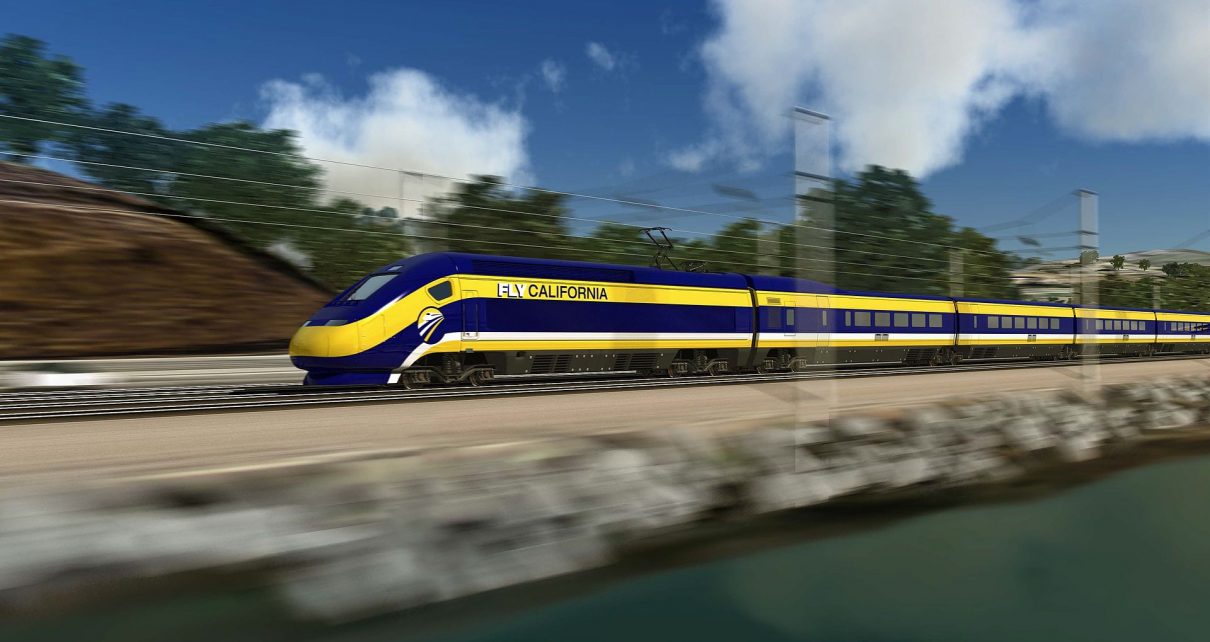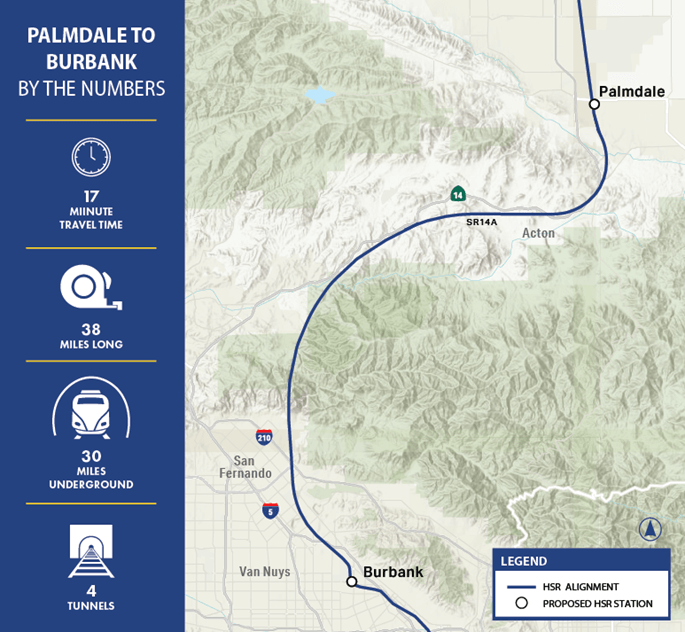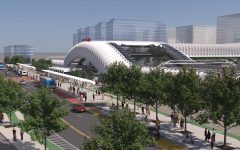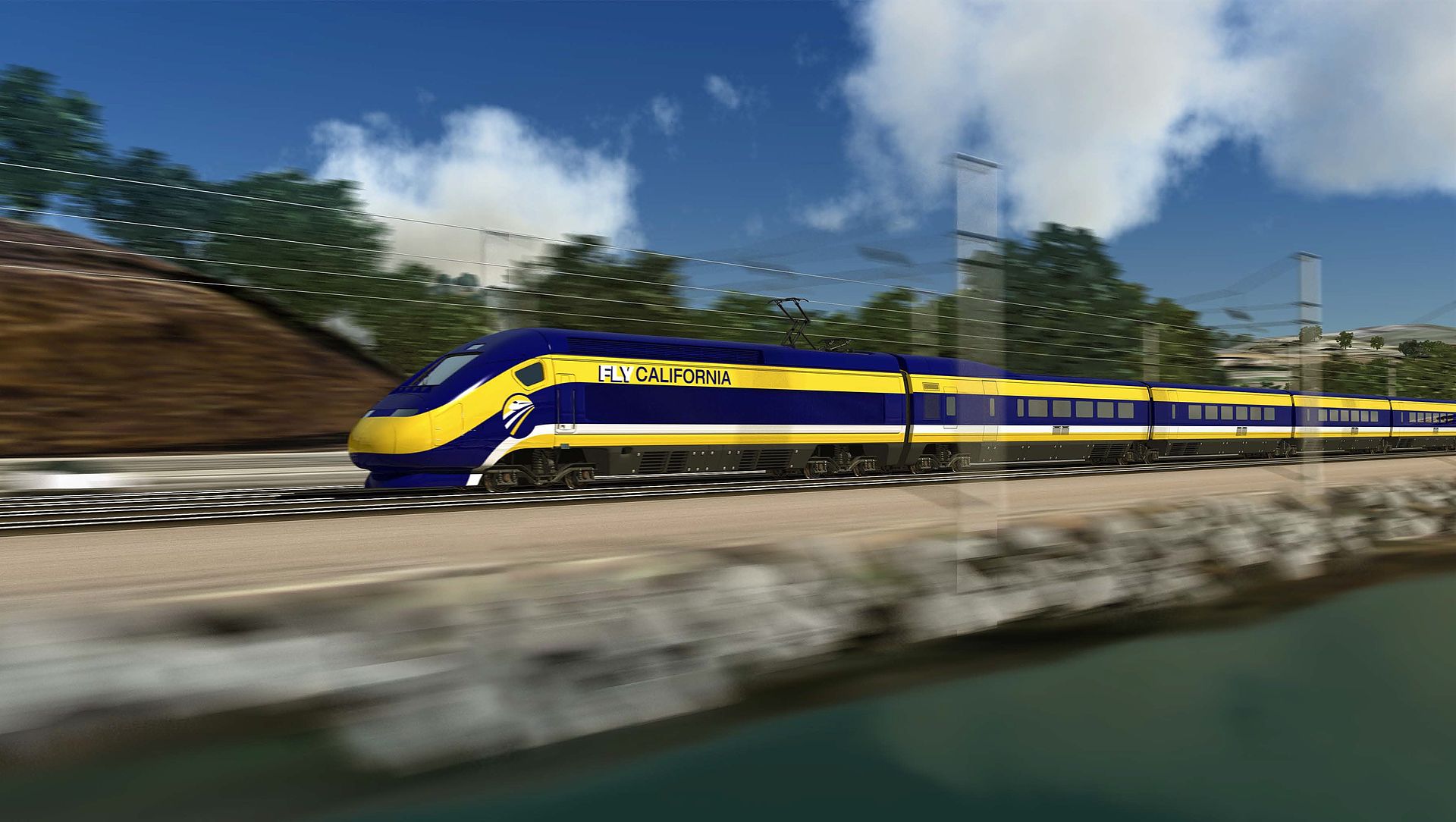
High Speed Rail train, artists rendering. (Photo: CHSRA.ca.gov)
30 Miles of Tunnels Proposed for High Speed Rail: Can You Dig It?
The entirety of the project has been plagued by massive cost overruns and decade-plus delays
By Thomas Buckley, June 29, 2024 2:00 pm
The consistently accurate and forward looking board of the California High Speed Rail Authority has decided that it is a good idea to dig 30 miles of tunnels to connect Burbank to Palmdale.
The purely political zig-zag to include Palmdale in the system (votes in the Antelope Valley) of the high speed rail from Los Angeles to San Francisco is about 38 miles and earlier this week the Board approved an environmental impact report that sets out an 8 mile above-ground, 30 mile below-ground route to make the connection.
The Authority claims the route will cost about $28 billion dollars to complete. For comparison’s sake, that is about 80% of the originally promised costs of the entire system connecting San Diego to LA to SF to Sacramento.
It should be noted that the cost was originally reported by news outlets as being $22.6 billion – but the Authority clarified Thursday that was in 2018 dollars, so now it’s really about $28 billion dollars.
The plan voters approved was to build a system of about 840 miles for about $33 billion.
Admittedly, at a cost of about $736 million dollars a mile, the cost estimate is not technically impossible, considering the prices of other massive recent tunneling projects.
That, of course, discounts the fact that the entirety of the project has been plagued by massive cost overruns and decade-plus delays. If looking at past financial projections made by the high speed rail folks are any indication, the project could very easily end up costing about triple that amount, or more than double the original proposed cost for the entire system.
The high speed rail folks say the entire Burdale or Palmbank (or whatever it will be nicknamed) trip will take about 17 minutes, which equates to a speed of about 120 miles per hour, though they claim at least a bit of the journey will hit “up to 220 miles per hour.”
Saying the 17 minute ride is more than “twice as fast as traveling by car,” HSR Authority CEO Brian Kelly said the route approval moves the link to being closer to “shovel ready,” … “as funding becomes available.”
“This is a transformative project for the state of California as a whole, and today’s approval is a major milestone for connecting San Francisco to Los Angeles in less than three hours,” Kelly said. “It’s also transformational for Los Angeles County, connecting Palmdale to Burbank in a way that’s never been possible before.”
The route chosen will run partly along State Route 14. It will be a grade-separated, high-speed rail-only system, and trains will be underground through the community of Acton and much of the Angeles National Forest and the San Gabriel Mountains National Monument.

If completed (I know, but I have to say that, just in case – it’s like ‘what would you do if you won the lottery?’) the tunnel system would be one of the longest in the world, making this one of the biggest and most serious engineering projects attempted for decades. For comparison, the tunnel under the English Channel – the Chunnel – connecting France and Britain is only about 21 miles long – actually the entire trip from Paris to London, not just the Chunnel part – takes about two hours.
The timing of the project is unknown, though as it is apparently dependent upon finding the money to build it – and the high speed rail people are the ones doing it – a fair projection could be “second star to the right and straight on ‘til morning.”
You know – Neverland.
- Benefit Fraud Problems and Solutions - November 7, 2024
- A Little Exit Poll - November 5, 2024
- Tomorrow’s Headlines Today! - November 5, 2024




so that means $280 Billion, right?
“…The Authority claims the route will cost about $28 billion dollars to complete. For comparison’s sake, that is about 80% of the originally promised costs of the entire system connecting San Diego to LA to SF to Sacramento.
It should be noted that the cost was originally reported by news outlets as being $22.6 billion – but the Authority clarified Thursday that was in 2018 dollars, so now it’s really about $28 billion dollars. …”
That is correct
Meanwhile, the state is broke, the roads are the worst in the nation, the water system hasn’t been updated in decades, the prisons are being emptied, but at least we’ll have a train tunnel. I for one would not want to be in that tunnel when there is a failure, fire, blackout, or crash. I’m not going into a tunnel built by the Democrats. Everything they touch turns to sh*t.
Ex-President Trump would like a word with you.
Thirty miles underground…..how many active earthquake faults are there in this underground stretch? Do Governor Climate Change and the Dems have an escape plan in the event of an earthquake in this long tunnel? I think I will take my chances in the comfort of my motor vehicle.
According to the published report on the route most of the tunnel miles are very high seismic risk zones. Crossing two major faults and related fault system. One is the San Andreas.
What the “Section 3.9 Geology, Soils, Seismicity, and Paleontological Resources” report totally downplays is that all the seismic maps (Page 3.9 – 44 onwards) show as green “nonhazardous” seismic zones active areas that have produced the majority of serious earthquakes in the last 100 years in the Southlands. Previously conceded safe “nonhazardous” seismic zones.
And that is without getting into the unknown blind thrust faults that riddle these mountains and lowlands. Which produced both the Whitter earthquake and the Northridge earthquake. Both on faults previously unknown.
Then there is the problem of evacuation of these tunnels after an earthquake. Apart from a passing mention of large earthquake resistant unground galleries and surface access tunnels zero thought seems to have been given to seismic safety. For comparison the Channel Tunnel has two separate tunnels plus a third service tunnel. All fully isolatable if needed in an emergency. And it does not cross two major earthquake fault zones.
great comment – in fact, i appended it the substack version of the story: https://thomas699.substack.com/p/can-you-dig-it
Great comment, TF! I was thinking the exact same thing, that this route literally cuts across the San Andreas Fault and is through one of the most seismically active zones in Southern California…>
But don’t bother mentioning actual science to progressive Democrat$… it gets in the way of their “green” narrative…
No mention of outsourcing the tunneling project to Musk’s “Boring Company”???
We are led by complete IDIOTS in Sacramento….
Burbank’s so-called leaders currently in power are determined to turn that city into a Jenga stack. To your point: SEE Joseph H. Birman’s “The Case for a Burbank Fault, San Fernando Valley, California” ENVIRONMENTAL AND ENGINEERING GEOSCIENCE 1 (4): 417-426 (December 1995).
If you really want to understand what’s going on with the “Tunnel to Nowhere” just look at who has received money so far.
My engineering judgement says these clowns will never solve the technical challenges involved. But you don’t even have to be an engineer to see that.
CAN YOU DIG IT is one thing, however CAN YOU SPOIL IT, namely where with the tunnel spoils (muck) be disposed of in the LA basin. Check the local agencies and some have no off site disposal with developments And what about truck traffic hauling a million yards away with air quality and all.
They’ll use electric trucks, I’m sure. What, with the mandates coming soon.
Seems like Democrats LOVE the “underground”–they always try to make CA a sunshine state of Hell. tunnels under the runny soil Delta for H2O flow, tunnels under shaky mountains between Palmdale and Burbank. These are major engineering feats, COSTLY if ever undertaken and completed. In fact, taxpayer money tossed down a money pit.
The only requirement of the BS train is to pay off union labor. It does not matter if they built pyramids in the Mohave instead.
This is not a transportation scheme, but a union money transfer scheme for continued support of the elite cadre’ that runs California.